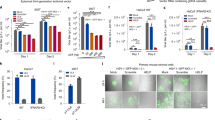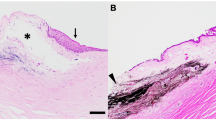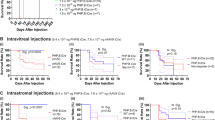Abstract
Corneal graft rejection is a major problem in chronic herpetic keratitis (HK) patients with latent infection. A new class of antiviral agents targeting latent and active forms of herpes simplex virus type 1 (HSV-1) is importantly required. Meganucleases are sequence-specific homing endonucleases capable of inducing DNA double-strand breaks. A proof-of-concept experiment has shown that tailor-made meganucleases are efficient against HSV-1 in vitro. To take this work a step forward, we hypothesized that the pre-treatment of human corneas in eye banks using meganuclease-encoding vectors will allow HK patients to receive a medicated cornea to resist the recurrence of the infection and the common graft rejection problem. However, this strategy requires efficient gene delivery to human corneal endothelium. Using recombinant adeno-associated virus, serotype 2/1 (rAAV2/1), efficient gene delivery of a reporter gene was demonstrated in human corneas ex vivo. The optimum viral dose was 3.7 × 1011 VG with an exposure time of 1 day, followed by 6 days incubation in de-swelling medium. In addition, 12 days incubation can result in transgene expression in excess of 70%. Using similar transduction conditions, meganuclease transgene expression was detected in 39.4% of the endothelial cells after 2 weeks in culture. Reduction of the total viral load in the media and the endothelial cells of corneas infected with HSV-1 was shown. Collectively, this work provides information about the optimum conditions to deliver genetic material to the cornea, and demonstrates for the first time the expression of meganuclease in human corneas ex vivo and its antiviral activity. In conclusion, we demonstrate that the treatment of human corneas in eye banks before transplantation is a new approach to address the unmet clinical needs in corneal diseases.
This is a preview of subscription content, access via your institution
Access options
Subscribe to this journal
Receive 12 print issues and online access
$259.00 per year
only $21.58 per issue
Buy this article
- Purchase on Springer Link
- Instant access to full article PDF
Prices may be subject to local taxes which are calculated during checkout









Similar content being viewed by others
References
Shtein RM, Garcia DD, Musch DC, Elner VM . Herpes simplex virus keratitis: histopathologic inflammation and corneal allograft rejection. Ophthalmology 2009; 116: 1301–1305.
Panda A, Vanathi M, Kumar A, Dash Y, Priya S . Corneal graft rejection. Surv Ophthalmol 2007; 52: 375–396.
Liesegang TJ . Herpes simplex virus epidemiology and ocular importance. Cornea 2001; 20: 1–13.
Kaye S, Choudhary A . Herpes simplex keratitis. Prog Retinal Eye Res 2006; 25: 355–380.
McGeoch DJ, Dalrymple MA, Davison AJ, Dolan A, Frame MC, McNab D et al. The complete DNA sequence of the long unique region in the genome of herpes simplex virus type 1. J Gen Virol 1988; 69 (Pt 7): 1531–1574.
Efstathiou S, Minson AC, Field HJ, Anderson JR, Wildy P . Detection of herpes simplex virus-specific DNA sequences in latently infected mice and in humans. J Virol 1986; 57: 446–455.
Mellerick DM, Fraser NW . Physical state of the latent herpes simplex virus genome in a mouse model system: evidence suggesting an episomal state. Virology 1987; 158: 265–275.
Rock DL, Fraser NW . Latent herpes simplex virus type 1 DNA contains two copies of the virion DNA joint region. J Virol 1985; 55: 849–852.
Lomholt JA, Baggesen K, Ehlers N . Recurrence and rejection rates following corneal transplantation for herpes simplex keratitis. Acta Ophthalmologica Scandinavica 1995; 73: 29–32.
Halberstadt M, Machens M, Gahlenbek KA, Bahnke M, Garweg JG . The outcome of corneal grafting in patients with stromal keratitis of herpetic and non-herpetic origin. Br J Ophthalmol 2002; 86: 646–652.
Remeijer L, Duan R, van Dun JM, Bettink MAW, ADME Osterhaus, Verjans GMGM . Prevalence and clinical consequences of herpes simplex virus type 1 DNA in human cornea tissues. J Infect Dis 2009; 200: 11–19.
Elbadawy HM, Gailledrat M, Desseaux C, Ponzin D, Ferrari S . Targeting herpetic keratitis by gene therapy. J Ophthalmol 2012; 2012: 14.
Symington LS . Role of RAD52 epistasis group genes in homologous recombination and double-strand break repair. Microbiol Mol Biol Rev 2002; 66: 630–670.
Michel B, Grompone G, Flores MJ, Bidnenko V . Multiple pathways process stalled replication forks. Proc Natl Acad Sci USA 2004; 101: 12783–12788.
Paques F, Haber JE . Multiple pathways of recombination induced by double-strand breaks in Saccharomyces cerevisiae. Microbiol Mol Biol Rev 1999; 63: 349–404.
McEachern MJ, Haber JE . Break-induced replication and recombinational telomere elongation in yeast. Annu Rev Biochem 2006; 75: 111–135.
Surralles J, Jackson SP, Jasin M, Kastan MB, West SC, Joenje H . Molecular cross-talk among chromosome fragility syndromes. Genes Dev 2004; 18: 1359–1370.
Kennedy RD, D'Andrea AD . The Fanconi Anemia/BRCA pathway: new faces in the crowd. Genes Dev 2005; 19: 2925–2940.
Hickson ID . RecQ helicases: caretakers of the genome. Nat Rev Cancer 2003; 3: 169–178.
Porteus MH, Baltimore D . Chimeric nucleases stimulate gene targeting in human cells. Science 2003; 300: 763–763.
Galetto R, Duchateau P, Paques F . Targeted approaches for gene therapy and the emergence of engineered meganucleases. Expert Opin Biol Ther 2009; 9: 1289–1303.
Thierry A, Dujon B . Nested chromosomal fragmentation in yeast using the meganuclease I-Sce I: a new method for physical mapping of eukaryotic genomes. Nucleic Acids Res 1992; 20: 5625–5631.
Porteus MH, Cathomen T, Weitzman MD, Baltimore D . Efficient gene targeting mediated by adeno-associated virus and DNA double-strand breaks. Mol Cell Biol 2003; 23: 3558–3565.
Hirsch ML, Green L, Porteus MH, Samulski RJ, Self-complementary AAV . mediates gene targeting and enhances endonuclease delivery for double-strand break repair. Gene Therapy 2010; 17: 1175–1180.
Grosse S, Huot N, Mahiet C, Arnould S, Barradeau S, Le Clerre D et al. Meganuclease-mediated inhibition of HSV1 infection in cultured cells. Mol Ther 2011; 19: 694–702.
Rousseau A, Ergani A, Gabison E, Corral M, Gailledrat M, Desseaux C et al. Gene transfer of HSV1 specific meganuclease to the murine cornea. Acta Ophthalmologica 2012; 90 (Suppl 249)abstract T043.
Labetoulle M, Gabison E, Rousseau A, Huot N, Chapellier B, Gailledrat M et al. HSV1?specific meganuclease may reduce ocular infection in a mouse model of herpes keratitis. Acta Ophthalmologica 2012; 90 (Suppl 249)abstract F084.
Chapellier B, Labetoulle M, Gailledrat M, Gabison E . Meganuclease targeting HSV-1 limits viral endothelitis in vivo. Acta Ophthalmologica 2012; 90 (Suppl 249)abstract 2631.
Fuchsluger TA, Jurkunas U, Kazlauskas A, Dana R . Anti-apoptotic gene therapy prolongs survival of corneal endothelial cells during storage. Gene Therapy 2011; 18: 778–787.
Pruett-Miller SM, Reading DW, Porter SN, Porteus MH . Attenuation of zinc finger nuclease toxicity by small-molecule regulation of protein levels. PLoS Genet 2009; 5: e1000376–e1000387.
Christian M, Cermak T, Doyle EL, Schmidt C, Zhang F, Hummel A et al. Targeting DNA double-strand breaks with TAL effector nucleases. Genetics 2010; 186: 757–761.
Paques F, Duchateau P . Meganucleases and DNA double-strand break-induced recombination: perspectives for gene therapy. Curr Gene Ther 2007; 7: 49–66.
Porteus MH, Carroll D . Gene targeting using zinc finger nucleases. Nat Biotechnol 2005; 23: 967–973.
Wolf AH, Welge-Luen UC, Priglinger S, Kook D, Grueterich M, Hartmann K et al. Optimizing the deswelling process of organ-cultured corneas. Cornea 2009; 28: 524–529.
Bourne WM . Clinical estimation of corneal endothelial pump function. Trans Am Ophthalmol Soc 1998; 96: 229.
Kotin RM, Linden RM, Berns KI . Characterization of a preferred site on human chromosome 19q for integration of adeno-associated virus DNA by non-homologous recombination. EMBO J 1992; 11: 5071.
Linden RM, Ward P, Giraud C, Winocour E, Berns KI . Site-specific integration by adeno-associated virus. Proc Natl Acad Sci USA 1996; 93: 11288–11294.
Chen CL, Jensen RL, Schnepp BC, Connell MJ, Shell R, Sferra TJ et al. Molecular characterization of adeno-associated viruses infecting children. J Virol 2005; 79: 14781–14792.
Rabinowitz JE, Samulski J . Adeno-associated virus expression systems for gene transfer. Curr Opin Biotechnol 1998; 9: 470–475.
Zolotukhin S . Production of recombinant adeno-associated virus vectors. Hum Gene Ther 2005; 16: 551–557.
McCarty DM, Young SM Jr, Samulski RJ . Integration of adeno-associated virus (AAV) and recombinant AAV vectors. Annu Rev Genet 2004; 38: 819–845.
Zhang Y, Chirmule N, Gao G, Wilson J . CD40 ligand-dependent activation of cytotoxic T lymphocytes by adeno-associated virus vectors in vivo: role of immature dendritic cells. J Virol 2000; 74: 8003–8010.
Bessis N, GarciaCozar FJ, Boissier MC . Immune responses to gene therapy vectors: influence on vector function and effector mechanisms. Gene Therapy 2004; 11: S10–S17.
Vandenberghe LH, Wilson JM . AAV as an immunogen. Curr Gene Ther 2007; 7: 325–333.
Zaiss AK, Muruve DA . Immune responses to adeno-associated virus vectors. Curr Gene Ther 2005; 5: 323–331.
Mason JB, Vandenberghe LH, Xiao R, Wilson JM, Richardson DW . Influence of serotype, cell type, tissue composition, and time after inoculation on gene expression in recombinant adeno-associated viral vector-transduced equine joint tissues. Am J Vet Res 2012; 73: 1178–1185.
Ganella DE, Callander GE, Ma S, Bye CR, Gundlach AL, Bathgate RAD . Modulation of feeding by chronic rAAV expression of a relaxin-3 peptide agonist in rat hypothalamus. Gene Therapy 2013; 20: 703–716.
Reimsnider S, Manfredsson FP, Muzyczka N, Mandel RJ . Time course of transgene expression after intrastriatal pseudotyped rAAV2/1, rAAV2/2, rAAV2/5, and rAAV2/8 transduction in the rat. Mol Ther 2007; 15: 1504–1511.
Yan Z, Lei-Butters DCM, Liu X, Zhang Y, Zhang L, Luo M et al. Unique biologic properties of recombinant AAV1 transduction in polarized human airway epithelia. J Biol Chem 2006; 281: 29684–29692.
Lai LJ, Lin KK, Foulks GN, Ma L, Xiao X, Chen KH . Highly efficient ex vivo gene delivery into human corneal endothelial cells by recombinant adeno-associated virus. Curr Eye Res 2005; 30: 213–219.
Wang J, Zhao G, Xie L, Chen M, Zhao J . Therapeutic effect of deep anterior lamellar keratoplasty for active or quiescent herpetic stromal keratitis. Graefes Arch Clin Exp Ophthalmol 2012; 250: 1187–1194.
Anwar M, Teichmann KD . Big-bubble technique to bare Descemet's membrane in anterior lamellar keratoplasty. J Cataract Refract Surg 2002; 28: 398–403.
Alekseev O, Tran AH, Azizkhan-Clifford J . Ex vivo organotypic corneal model of acute epithelial herpes simplex virus type I infection. J Visualized Exp 2012; 69: e3631.
La Boissiere S, Izeta A, Malcomber S, O'Hare P . Compartmentalization of VP16 in cells infected with recombinant herpes simplex virus expressing VP16-green fluorescent protein fusion proteins. J Virol 2004; 78: 8002–8014.
Acknowledgements
This work was partly supported through grants from the Italian Ministry of Health (CUP: H31J11000260001 and CUP: H41J12000100001).
Author information
Authors and Affiliations
Corresponding author
Ethics declarations
Competing interests
The authors declare no conflict of interest.
Rights and permissions
About this article
Cite this article
Elbadawy, H., Gailledrat, M., Desseaux, C. et al. Gene transfer of integration defective anti-HSV-1 meganuclease to human corneas ex vivo. Gene Ther 21, 272–281 (2014). https://doi.org/10.1038/gt.2013.82
Received:
Revised:
Accepted:
Published:
Issue Date:
DOI: https://doi.org/10.1038/gt.2013.82
Keywords
This article is cited by
-
Genome editing and the next generation of antiviral therapy
Human Genetics (2016)



